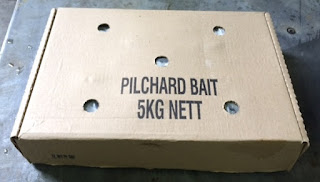The Department of Agriculture, Forestry & Fisheries (DAFF) provided data for fisheries effort, catch and bycatch data and data to support ecosystem based management of fisheries. Various other scientists and interested bodies participated with the submission and interpretation of the data collected.
When SANBI set about the MPA process, they had to select a mechanism to assess the effect of the MPA on industry, and settled on fishing effort per area. It would have made more sense to use actual "Rands and Cents." The cost effect of effort can be confounded by seasonal changes and species types. A useful example may be found in fishing for Southern Bluefin Tuna (SBT). Actual effort on SBT might be low as the fish are only present for a part of the year and in discreet locations. Raw effort data would show that SBT grounds are of low value or "cost". However, the "Rands and Cents" costs might actually be huge. A parallel can be drawn at the time of compiling these reports (majority being done during 2011), when the albacore tuna price was much lower than what it is at today's rate (highest rate per kilogram in the history of the South African tuna fishery). The cost of this fishery has more than tripled in comparison to the reports data logged back then.
Other issues that I am not able to understand is how they would propose to close an area to pelagic longline and tuna pole and leave it open to south coast rock lobster or linefishing. South Coast rock lobster traps are set on the bottom of the sea floor. These traps remove south coast rock lobster and some other marine life from the ecosystem and and the effect of dragging a string of pots along the bottom can be notably significant. The large pelagic fishing methods for tuna (longline and pole & line) only effect the upper layer of the ocean, ie the surface and up to 80 fathoms (possibly deeper). The proposed closures are to protect species and their breeding grounds such as the SASSI orange listed kingklip and to provide sanctuaries for species such as the blue shark. Similarly linefish has a list of prescribed species but the mortality on other species is significant. Linefishing techniques involve sending a lure to the bottom and working it up the surface. Most fish species with a swim bladder caught in deeper water and released will have a significant post release mortality.
These effects that are permitted challenge the rationality of excluding pelagic longlining and pole & line for tuna. It is possible that it was excluded because of a sense that large pelagics takes place on a greater scale then that can be resolve through other mechanisms that are less drastic than a hard MPA.
Should the DEA successfully gazette these MPA's, then this will effectively shut off productive fishing grounds for the tuna fishermen. As the tuna are migratory species, our fishing method for targeting these tunas are to follow the shoals along our coast line for the the limited time of the season that they found to be present. Industry is busy with the consultative process with government challenging their proposal within reason. Needless to say then dealing with government, the wheels turn ever so slowly...
Below is a map indicating the various MPA's proposed by government:
Below is a table showing the offshore biodiversity protection including key objectives, stakeholders & management consideration:



















